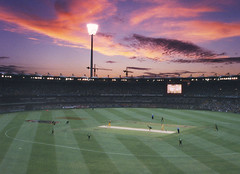How to win more evening cricket matches

 photo credit: Rick212
photo credit: Rick212It's quite something to think that club cricketers have been playing the shortest version of the game since the first after work matches in the 1920s.
And the IPL thought Twenty20 was a new idea.
Generations of club players have grown up in the format that takes a couple of hours. In recent times the top players have shown the club game how it is done. What can we learn from them, and what should be cast aside when trying to win our local competitions?
Here are some things to consider that differ from the usual club cricket tactics.
Selection
Most clubs don't have a choice when it comes to selection. If you are available, you play. However there are some principles of evening cricket that might influence your choice of players (or who you try and cajole into playing at the last minute).
- Batsman are more important than bowlers. Always stack your side with players who can bat.
- Go for the long ball. Big hitters should be picked ahead of accumulators.
- Pick spinners. Spin and gentle medium pace is harder to hit than traditional seam or swing bowling.
- Fitness is a vital factor. Look for players with speed over the ground and fast recovery times.
- Fielding can make the difference. Consider picking exceptional fielders even if they can’t bat or bowl to standard. Also, practice your fielding religiously.
Batting
Contrary to popular belief, you don't have to swing from the first ball. While even top order batsmen will find it tough to face more than 60 balls, there is still enough time to build an innings.
- Look to score off every ball. There are more runs available than you might think. Unless the ball goes straight to a fielder at pace you can usually make a run. Practice working the ball into open areas through hitting over the top or adjusting the face of the bat and ‘punching’ through your defensive shots.
- Hit sixes. While accumulation is important, the bad balls are best put out of the park. That means putting the big hitters up the order and giving them free reign. It also means practising hitting the ball in the air sometimes. Club players are taught from a young age to hit the ball on the ground. Usually this is right, but the well chosen aerial route gives you more runs.
- Think in areas, not shots. Tradition dictates that certain types of balls are responded to with certain types of shots. This allows fielding captains to predict where the ball is going to be far more easily. Instead think about areas on the park where you know you can hit the ball to confound the captain. It might mean learning to sweep more effectively or even playing the hoick to cow corner now and again, as long as you back yourself to do it then why not?
- Stand still. Modern Twenty20 sees player running all over the crease. That’s fine if you can do it to put off the batsman, but a fundamental element of hitting the ball is having a still head. If you are going to move, make sure your head is still at the point of delivery. I prefer seeing players adjust where they stand in the crease instead. Standing back in the crease at the death can turn yorkers into half volleys for example.
- Set targets. Try to work out before the match how many runs are in the wicket. Spilt this target into three phases: Opening, middle and death. Set run targets for each phase with your batting partner. This makes it easier to reach your goal as you know if you are behind or ahead at any given moment. Even in the short game there are periods where innings can 'tick over' if the side is cruising or recovering from a collapse.
Bowling
- Learn your variations. Bowling in the short game is no fun when you are getting slapped all over the place while bowling length. Learn and practice as many variations as you can. Start with an accurate slower ball and move on to bowling yorkers at will. If you master those two in combination with traditional line and length you will be a very useful bowler. Also, use the width of the crease.
- If in doubt, slow down. The faster you bowl the harder you can be hit, so don't be afraid to take the pace off the ball no matter how slow you think you are already. You can further vary your speed by bowling from further back in the crease. This has the combined effect of rushing the batsman and slowing the arrival of the ball.
- Know your place. Even on lesser club wickets, bowling is the harder discipline in short games. Have a plan and be prepared to stick to it. You only have so many balls to bowl and there are only so many scenarios to bowl in so you can plan in advance, especially if you know the opposition well and have weaknesses you can exploit.
- Follow the ball. It's best to plug the gaps with fielders as quickly as you can. That means initially following the ball with field placings. It also means making sure your best fielders are where the ball is going and not just sat in the covers automatically.
- Login to post comments

